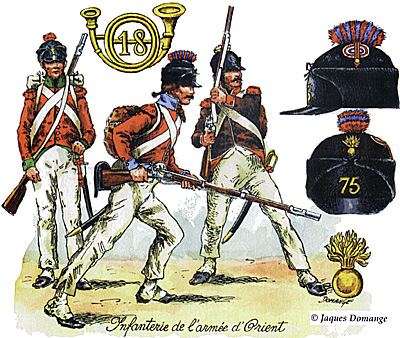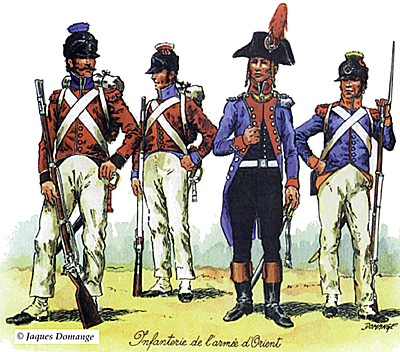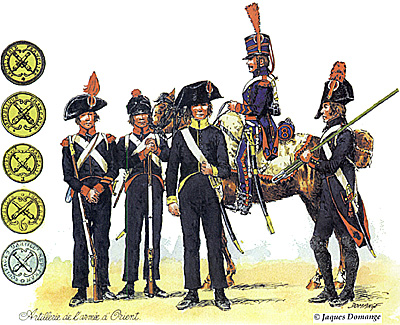General Bonaparte's expedition to Egypt included a newly formed Army of the Orient organized in Toulon in 1798 with approximately 36,000 men. The infantry were all veterans of Bonaparte's Army of Italy and included fourteen demi-brigades (a demi-brigade was equivalent to a regiment, with three battalions). Four light demi-brigades included the 2nd, 4th, 21st, and 22nd, while the other ten demi-brigades were line units: 9th, 13th, 18th, 25th, 32nd, 61st, 69th, 75th, 85th and 88th. Light units were supposed to be better at skirmishing and loose order combat, and they asserted the right to lead all attacks.
Upon arrival in Egypt in July 1798, the infantry wore the standard blue and white uniform of the French army made of woolen cloth. During the first weeks in Egypt, it became obvious to the general-in-chief that their clothing had to be redesigned to be better adapted to the hot Egyptian climate. Consequently, Bonaparte created a committee to revise the army's clothing and equipment.
The committee quickly recommended to replace the traditional uniform coat with a habit-veste (short coat) without lapels, buttoned straight on the chest, made with blue cotton cloth. The collar and the facings were to be red. The trousers were to be made of white cotton cloth for the line infantry and of blue cotton cloth for the light infantry. These uniforms were made and distributed to the army during the month of August 1798, after the battle of the Pyramids and conquest of Cairo. Almost immediately, it was discovered that the cotton clothing did not protect the soldiers sufficiently during the cold nights.
The following year a decision was made to replace these cotton uniforms with new ones made of woolen cloth. However, sufficient quantities of blue woolen cloth could not be found locally and few supplies sent from France were able to evade the British blockade and reach Egypt. Therefore, by an order dated 15 August 1799 only the artillery and sappers (combat engineers) would wear the blue woolen cloth. The infantry was to receive woolen clothing of different colors: light green, sky blue, crimson, etc. (See chart page 59)
The colors allocated to each demi-brigade were specified by General Kléber that same date. As can be seen in the color chart on page 59, the initial coat and facing colors would change between October and November for many demi-brigades. [The conflicting data on the colors seem to be due to changes made because of shortages in the original colors chosen before the uniforms were made.]
The new uniforms were distributed to the army beginning on 22 December 1799, after the return from the Syrian campaign. These uniforms were worn by the soldiers until they were repatriated to France in 1801. [Records show that French losses in the expedition to Egypt were 16,772 by March 1801 against a total of 35,720 men present under arms as of 1 January 1799.]
The infantry wore the standard issue bicorn hat when they departed from France. These soon needed replacement and it was decided to issue a new headdress called in the official documents of the period casque, casquette, bonnet de cuir, etc. Looking much like a modern jockey cap, the new hat was distributed to the demi-brigades between October 1799 and January 1800. [An article by noted uniform artist M. Albert Rigondaud ("Rigo") notes that the grenadiers of the demi-brigades may have kept their bicorns and the sapeurs their bearskins.] It was topped with a puff of different colors for each demi-brigade and the colors were regulated by an order dated 13 September 1799.
The puff colors were 2nd Light, green; 4th Light, green and white; 21st Light, green and yellow; 22nd Light, green and red; 9th Line, red; 13th Line, blue; 18th Line, black; 25th Line, red and white; 32nd Line, blue and white; 61st Line, black and white; 69th Line, yellow and white; 75th Line, blue and red; 85th Line, yellow and red; 88th Line, yellow and blue.
The uniforms described above, and shown on the drawings, were worn between December 1799 and September 1801. [Rigo mentions a report of General Lecourbe dated 8 February 1802 while inspecting the 88th Demi-brigade stationed in Grenoble: "…The demi-brigade has not received new uniforms and still wears the uniforms of the siege of Alexandria.…" So the uniforms originally designed for Egypt may have still been in use for a period after 1801.]
Illustrations
Grenadiers From left to right: 9th Demi-brigade, 75th demi-brigade, and 69th demi-brigade. On right, casquette (cap) of 75th based on only surviving example. The body of the cap was soft leather sewn in four pieces with the regimental number and grenade in brass.

13th, 22nd, and 21st From left to right: Grenadier of 13th demi-brigade, fusilier of 13th demi-brigade, officer of 22nd Light as per an original illustration by Genier-Taconville showing an official long coat but rounded turnbacks are probably a personal unauthorized feature, and carabinier (elite company) of the 21st Light demi-brigade.

Artillery Left to right: First gunner, garde battery, artillery worker (dress uniform), first gunner 8th regt of horse artillery, second gunner. On left, top to bottom, first two are artillery buttons for officers, then for gunners of 1st and 6th regts of foot artillery, and the last is a button of the artillery train.

Napoleon in Syria, 1799
-
Napoleon in Syria: Introduction
Napoleon in Syria: From Egypt to Acre
Napoleon in Syria: Siege of Acre
Napoleon in Syria: Aftermath of Acre
Napoleon in Syria: Rosetta Stone
Napoleon in Syria: Uniforms Illustrated 1799-81 (very slow: 337K)
Napoleon in Syria: Regt Uniform Color Chart 1799-81 (very slow: 388K)
Napoleon in Syria: Campaign Maps (slow: 264K)
Back to Table of Contents -- Napoleon #15
Back to Napoleon List of Issues
Back to MagWeb Master Magazine List
© Copyright 2000 by Napoleon LLC.
This article appears in MagWeb (Magazine Web) on the Internet World Wide Web.
The full text and graphics from other military history magazines and gaming magazines are available at http://www.magweb.com
Order Napoleon magazine direct